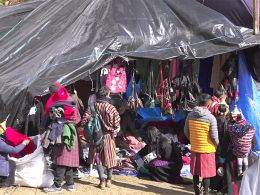In a move to address mounting challenges in urban sanitation, two key reports released yesterday have laid bare the pressing issues plaguing public toilets in Bhutan’s capital. The Bhutan Toilet Organisation (BTO), in collaboration with Thimphu Thromde, has outlined a strategic roadmap to revamp the city’s sanitation infrastructure — calling for better design, stronger maintenance systems, and a trained workforce.
The findings, detailed in the Urban Sanitation Review and Recommendations 2025 and the Public Toilet Assessment Report 2025, reveal a host of persistent problems including poorly designed septic tanks, frequent overflows, inadequate monitoring, and a lack of trained sanitation workers. These issues, according to officials, threaten the health, dignity, and comfort of urban residents and visitors alike.
“Previously, our focus was mainly on toilets themselves. But through this comprehensive study, we’ve assessed the entire sanitation service chain,” said Chablop Passu, Executive Director of Bhutan Toilet Organisation. “We’ve identified the gaps and made strategic recommendations that we believe will guide sanitation planning and help implement immediate improvements.”
The Urban Sanitation Review and Recommendations 2025 outlines a national-level vision for developing inclusive, resilient, and sustainable urban sanitation systems. It emphasizes the urgent need to raise awareness about proper septic tank construction, in line with the Septic Tank Manual 2013, and calls for enhanced training for sanitation technicians, clearer maintenance protocols, and increased collaboration with civil society organisations (CSOs).
The accompanying Public Toilet Assessment Report 2025, Bhutan’s first such detailed study on public toilet infrastructure, evaluates key criteria including accessibility, gender equity, safety, and facility management. Conducted according to the National Public Toilet Guidelines 2023, the report recommends a wide range of improvements, from redesigning outdated toilets and training facility managers, to mobilising funds through kiosks, cafés, and advertisements near toilet areas.
“This assessment helps us identify exactly which toilets need to be upgraded or relocated, and where new ones are required,” said Chablop Passu. “Our aim is to transform public toilets in Bhutan into world-class facilities over the coming years.”
In support of these efforts, the Bhutan Toilet Organisation has secured a Nu 7 million tied grant from the government. The funding will be used to renovate approximately 20 of Thimphu’s 44 public toilets over the next two years, incorporating recommendations from the new reports to ensure the upgraded facilities are cleaner, safer, and more accessible.
Officials note that these reforms are especially timely, given the city’s growing urban population and the increasing demand for public sanitation that is inclusive, efficient, and environmentally sound.
With renewed focus and strategic investment, Thimphu’s public sanitation system is poised for a much-needed transformation — aiming to deliver dignity and cleanliness to all users, regardless of age, ability, or gender.








